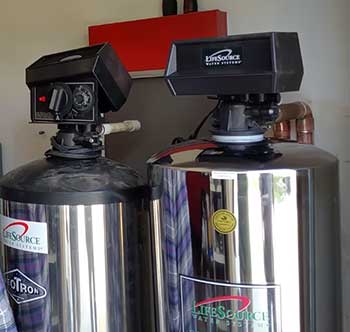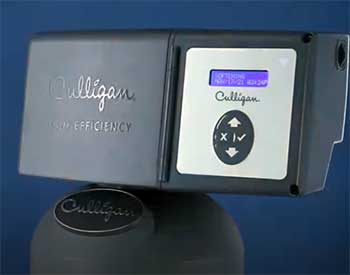Water filtration systems have gained increasing attention in our pursuit of clean, healthy water. Among the popular contenders in this space, LifeSource Water and Culligan Water stand out, offering an array of water treatment solutions.
Let’s dive into an analysis of the pros and cons of these two providers to help you make an informed decision.
A Brief Comparison Table
| Feature | LifeSource | Culligan |
| Water Softening | Salt-free (TAC) | Both salt-based and salt-free |
| Product Range | Limited to whole house water systems | Wide range, including RO systems |
| Purchase Options | Purchase only | Purchase and rental |
| Maintenance and Lifespan | Minimal maintenance, 10-20 years lifespan | Regular maintenance, lifespan varies |
| Environmental Impact | Eco-friendly, produces no wastewater | Depends on the specific system |
| Initial Cost | High | Varies; Rental option available |
| Customer Service | Generally positive | Mixed reviews, varies by location |
LifeSource Water Systems: The Pros

LifeSource Water Systems are lauded for their salt-free water softening process.
Their innovative technology prevents mineral buildup, prolonging the lifespan of your plumbing and appliances.
LifeSource water systems require minimal maintenance and no monthly salt purchase, making them a cost-effective choice for homeowners.
The overall quality of water produced by LifeSource is superior.
It removes unpleasant tastes and odors, leaving you with fresh, clean water every time you turn on the tap. Additionally, LifeSource’s proprietary systems are environmentally friendly, producing no wastewater or harmful byproducts.
LifeSource Water Systems: The Cons
While LifeSource offers many benefits, it also has its share of cons. Its initial setup cost is relatively high compared to other systems. Furthermore, despite being a salt-free system, it may not effectively soften water with very high hardness levels.
Finally, LifeSource’s systems don’t use reverse osmosis. Although their filtration process eliminates many impurities, it may not remove certain harmful contaminants that reverse osmosis effectively targets.
Culligan Water: The Pros

Culligan Water’s robust product range sets it apart. From water softeners and filtration systems to reverse osmosis systems, you can tailor your water treatment solution to fit your specific needs.
Culligan’s personalized service is another plus. Their representatives conduct in-home water tests to recommend the most suitable system for your home. This kind of hands-on approach helps ensure that you’re getting the best system for your unique circumstances.
Moreover, Culligan Water offers monthly rental options. This flexibility allows users to avoid large upfront costs, making water treatment more accessible to a broader range of customers.
Culligan Water: The Cons
While the rental option is convenient, it may prove more expensive in the long run. Users who choose this option could end up paying more than the cost of the system over time.
Additionally, some customers have reported less-than-stellar experiences with Culligan’s customer service. This varies by location, but it’s something to consider when choosing a water treatment provider.
Key Differences Between LifeSource and Culligan Water Systems
Understanding the key differences between LifeSource and Culligan water systems is crucial in deciding which one best fits your needs. Here are the major points of distinction.
Approach to Water Softening

LifeSource employs a salt-free method, called Template Assisted Crystallization (TAC), to prevent mineral buildup in your water.
This process transforms minerals into non-stick crystals, making LifeSource a great option for those who want to avoid the sodium added through traditional water softening techniques.
Culligan, on the other hand, offers both traditional salt-based water softeners and salt-free water conditioners. The choice between these two largely depends on your water’s hardness and your dietary preferences.
Filtration Technology
LifeSource systems utilize a multi-stage filtration process including activated carbon block filters, reverse osmosis, and UV light to remove a wide variety of contaminants from water.
Culligan systems rely on tank-style filters and ion exchange resin beads to primarily treat aesthetic issues like bad tastes, odors and chlorine. Culligan offers more advanced reverse osmosis upgrades for broader contaminant removal.
Contaminant Removal
Standard LifeSource filters remove over 140 potential contaminants including lead, radium, arsenic, chlorine byproducts, asbestos fibers, microplastics and more. It improves clarity and taste as well.
Culligan’s standard carbon tanks tackle basic taste and odor compounds like chlorine that affect water’s taste but don’t address major health contaminants like lead or arsenic. Upgraded Culligan reverse osmosis systems can handle those.
Installation

LifeSource systems are designed for DIY installation. Their quick-connect fittings allow homeowners to install their water filter themselves if desired. Professional installation is recommended but not required.
Culligan systems require professional installation and programming by a dealer to correctly size and configure the system for your home’s water conditions. The cost of professional installation is included with Culligan system purchases.
Maintenance
LifeSource filters should be replaced annually to maintain performance. This straightforward filter swap can be performed DIY-style fairly easily. Annual maintenance kits cost around $150.
Culligan’s ion exchange resin tank requires replacement every 2-5 years depending on water usage and quality. This complex service must be performed by Culligan dealers and costs $400-$700.
Product Range
Culligan boasts a more diverse product range than LifeSource. It provides not only water softeners and filters but also reverse osmosis systems. This variety gives you the flexibility to tailor your water treatment solution based on your specific needs.
LifeSource focuses primarily on whole house water systems. While this might be a limitation for some, it allows LifeSource to specialize in creating comprehensive, high-quality solutions for entire households.
Purchase Options
Culligan offers an appealing rental option for those who want to avoid hefty upfront costs. They allow customers to rent their water treatment systems, making their solutions more accessible.
LifeSource, conversely, offers their systems for purchase only. While this involves a larger initial investment, it can save money in the long run, especially considering LifeSource’s systems’ longevity.
Maintenance and Lifespan
LifeSource systems require minimal maintenance and have a longer lifespan – typically 10 to 20 years. This durability can translate into long-term savings and peace of mind.
On the contrary, Culligan systems require regular maintenance, such as salt replenishment in their traditional softeners, and their lifespan can vary depending on the specific product.
While both LifeSource and Culligan offer high-quality water treatment solutions, they cater to different needs and preferences. Understanding their key differences will guide you in making an informed decision about the best system for your home.
Frequently Asked Questions (FAQ)
LifeSource water filters are known for their longevity. Most models have a lifespan of 10 to 20 years, depending on usage and water quality.
Yes, Culligan water systems are designed to remove a wide range of contaminants, providing clean, safe water for your home. The effectiveness of the filtration depends on the specific system and the quality of your local water supply.
LifeSource systems do soften water, but they do so without the use of salt. They utilize a process known as Template Assisted Crystallization (TAC), which transforms the minerals in water into harmless, non-stick crystals.
No, LifeSource water systems do not use reverse osmosis. While they effectively filter out many impurities, certain contaminants that are removed by reverse osmosis systems may not be fully eliminated by LifeSource’s technology.
Basic Culligan tank systems effectively treat common water quality issues like bad tastes, odors and chlorine to improve quality. But they do not remove major health contaminants like lead without expensive reverse osmosis upgrades.
With proper maintenance like annual filter replacements, LifeSource systems can last 10-15 years or longer before any major components would need replacement due to normal wear.
Wrapping Up
In conclusion, both LifeSource and Culligan offer compelling solutions in the realm of water treatment. The choice between the two will largely depend on your specific water treatment needs, budget, and preference for customer service.
Always make sure to do your homework, ask questions, and weigh the pros and cons before making a decision.
